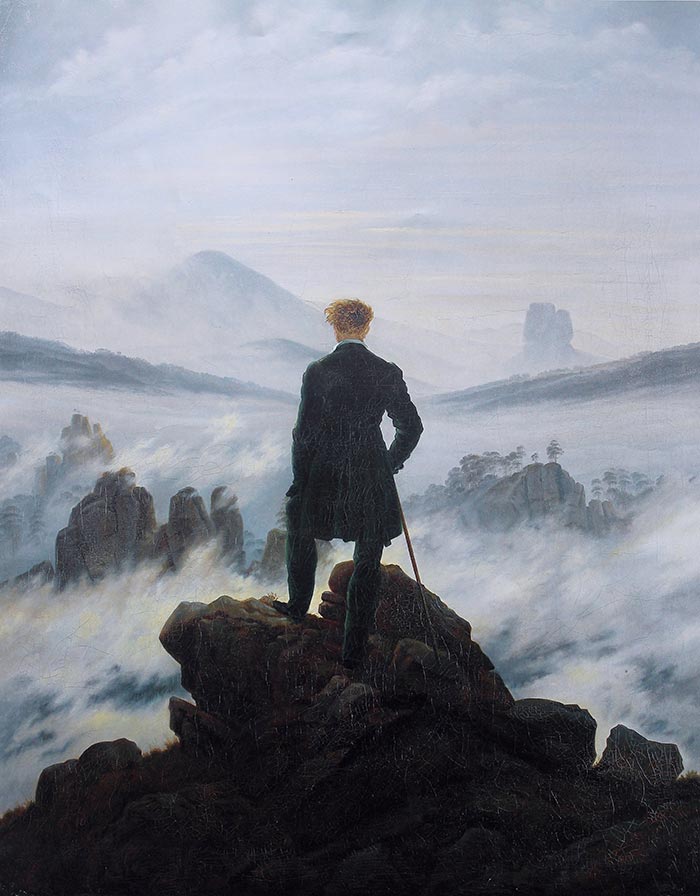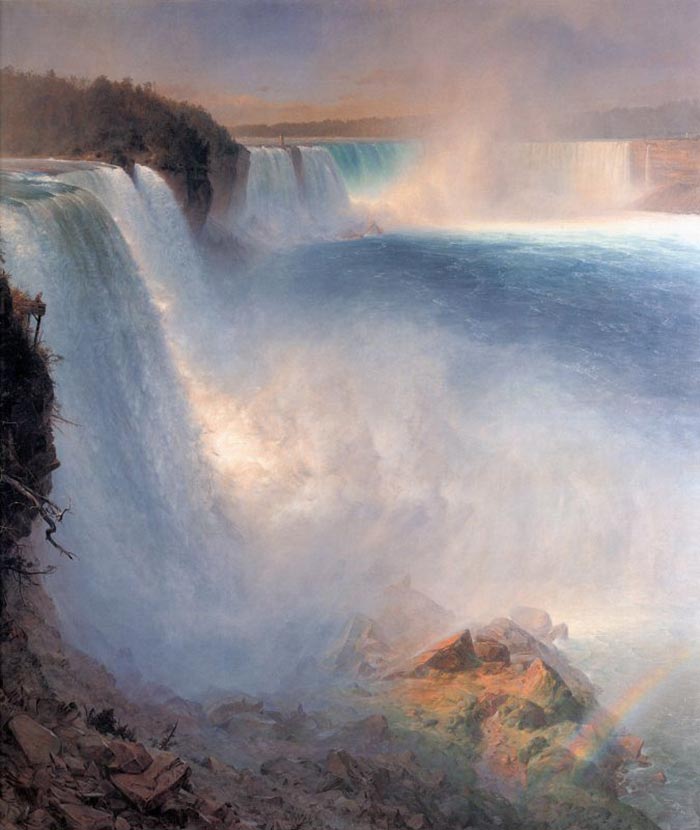How To Paint Mist With Acrylics
In this post, I provide you with some guidance on how to paint mist, fog, smoke, and other transient effects. These effects are typically challenging to capture on a flat surface due to their elusive and fleeting nature. Many artists seem to be either too timid with their approach, or too bold.
I cover the following areas:
- Shape, Form, and Movement
- Observe and Identify Colors
- Technique Selection
- Other Master Painting Examples
- Key Takeaways
I use my recent painting, New Zealand Reflections (shown below) along with several others by the masters to demonstrate key points.

Dan Scott, New Zealand Reflections, 2019
You should approach transient effects just like you would any other subject—look for basic shapes, forms, and movements. This is the main challenge of painting transient effects due to their fleeting and elusive nature. The shapes, forms, and movements will usually be hazy and indistinct, but they are there!
Ask yourself:
- If you had to draw an outline around the transient effect, what would that shape look like?
- Can you make out any geometric shapes (circles, triangles, squares)? These tend to be easier to measure and draw compared to irregular organic shapes.
- Is there a sense of three-dimensionality to the effect, or does it appear flat? Sometimes, the effect will have enough substance for you to make out different light and dark planes.
- What is the general sense of movement? It is going upward? Downward? To the right? To the left? Swirling? Still?
I will show you what I mean using myNew Zealand Reflections as an example. Below is the reference photo I painted from and a close-up of the mist sitting on the calm water:

New Zealand Reference Photo

The mist forms an organic shape which I have outlined below:

I can break this organic shape down into smaller, circular shapes that represent clusters of the mist. These shapes are weak and hardly distinguishable, but they are important to keep in mind as they help determine the kind of brushwork I use.

In terms of movement, the environment is very still. So much so that the water appears almost like a mirror reflection of the grand mountains in the distance. To capture that stillness in the painting, I avoided the use of any strong, directional brushwork.
I will run through another example using the stunning painting by Abram Arkhipov below namedLaundress:

Abram Arkhipov, Laundress, 1890
Here are some key observations regarding the steam which fills the room:
- His use of painterly brushwork, thick paint, and solid color gives substance to the hot steam.
- The edges of the steam are soft, but you can still make out the general shape of it.
- Notice how the steam forms a rough, diagonal line. This gives a feel of upward movement. By way of comparison, think about what the sense of movement would look like if the steam formed a horizontal line.
Mistakes in terms of color tend to stand out when painting transient effects. My best recommendation is to think in terms of color relationships, rather than absolute colors. By color relationships, I mean how light, dark, saturated, weak, blue, red or yellow the color is compared to its surroundings.
So, going back to the New Zealand reference photo, I can see the following color relationships between the mist and the surrounding colors:
- The mist is much lighter than the surrounding colors.
- The mist is much less saturated than the surrounding colors.
- The mist is a touch warmer in color temperature than the surrounding colors.
When I was mixing the color for the mist, I was thinking about these relationships.
The alternative would be to look at the color in the reference photo, determine exactly what color it is, and replicate that color in my painting. The problem with this approach is that it assumes the surrounding colors are the same in my painting. If they are not, then even if I mix the color exactly as it is in the reference photo, it will look wrong in the context of my painting.
The color I ended up using in the painting was a very light and slightly warm gray. However, looking back now the color seems to be too cool, which is a slight mistake.

Dan Scott, New Zealand Reflections, 2019
A color pitfall you need to be aware of is overusing white. We tend to associate mist, fog, and smoke as having a white appearance and this can interfere with our perception of color. Most of the time, you will find that light grays and other weak tones should be used for transient effects and pure white should be left for only the brightest of highlights, if at all.
In John Singer Sargent'sYoho Falls, the hazy spray of water is depicted with varying warm and cool grays. Even the lightest parts seem to have a touch of color in there.

John Singer Sargent, Yoho Falls, 1916
(If you want to learn more about color, you might be interested in my Painting Academy course.)
Your technique selection and implimentation is critical. Get it wrong, and your transient effect will appear out of place.
When I was paintingNew Zealand Reflections, I waited until the very end of the painting before I laid down the mist on the glassy water. Below is a progress shot of the painting before starting the mist. Notice how I blocked in the general colors as if the mist did not exist, rather than just leaving the area blank. This gave me the option to leave some of these colors exposed to capture the translucent nature of the mist.

Painting the mist this way presented a few challenges:
- If I painted the mist wrong, it would stand out and probably ruin the painting. The prominent position and lightness of the mist make it a key point of interest in the painting.
- Mistakes would bevery difficult to fix at this late stage of the painting. I could not simply wipe it down and start again. I either needed to get it mostly right the first time, or it was bust.
- The painting was 95% complete by the time I went to paint the mist. There was a risk I would play it too safe and paint timid in order to preserve the work I had already done. But remember, most of the great paintings we admire were not the result of playing it safe.
- The colors in my painting are slightly lighter and less saturated than the reference photo (I do not care for reproducing the photo exactly).That means, if I painted the color of the mist exactly as it is in the reference photo, it would look out of place in my painting. Instead, I needed to capture the color relationships, which I discussed earlier in this post (under Observe and Identify Colors).
To paint the mist, I first let the painting dry for a day. Then I used a dry brush to gently scumble color across the surface. Doing this allows some of the base colors underneath to remain exposed and give a sense of the mist's translucent nature.
I started by applying a few test strokes of light gray to see how well it fitted with the rest of the painting without committing to anything serious on the canvas. Once I was satisfied with the direction, I gradually committed to it.
I worked slowly through this process, as overdoing it would be a critical mistake. Too much color and paint would make the mist appear solid and lacking that transient feel.
Below are some other master painting examples of how to paint transient effects, starting with the appropriately namedFog, Voisins, by Alfred Sisley. It is not the most cheerful painting, but it certainly gives a sense of dense fog that fills the air.

Alfred Sisley, Fog, Voisins, 1874
In Wanderer Above the Sea of Fog, there is a powerful contrast between the dark, rigid, and imposing rocks in the foreground and the soft sea of fog.

Caspar David Friedrich, Wanderer Above the Sea of Fog, 1818
Below is more of an ambient display of fog. The edges are soft, the colors are muted, and there is a general haze across the whole painting.

Edward Pottast, Fog
Frederic Church depicts not only the soft haze of water spray from Niagara Falls, but also a fleeting rainbow in the bottom right-hand corner. Notice how Church's brushwork follows a rough, circular pattern, creating a sense of movement and drama. The rainbow is subtle and if I had to guess, I would say he used thin glazes of color over a dry foundation.

Frederic Edwin Church, Niagara Falls from the American Side, 1867
I could write a whole separate post about all the different studies of fog, mist, and transient effects by Claude Monet. He frequently painted the same subject over and over again under varying conditions to examine the changing of light and atmosphere. Below are just some of his paintings which feature misty and foggy conditions, starting with Homes in Falaise in the Fog. Without the vague depiction of the house, this would look more like a modern-day abstract piece.

Claude Monet, Homes of Falaise in the Fog, 1885
In his painting below of the Seine, Monet depicts the strong, warm light from the sunrise coming through the hazy mist on the water. The warm light appears diffused by the mist, but you still get a sense of its intensity.

Claude Monet, Misty Morning on the Seine, Sunrise, 1897
In Monet's painting below, you can only just make out the Palace of Westminster through the thick fog. Notice the subtle lights and use of saturated blue around the bottom of the Palace.

Claude Monet, The Palace of Westminster, The Fog Effect, 1903
Waterloo Bridge was a popular subject for Monet. In his painting below, he used varying blue and purple tones to depict the boats going under the bridge. There is also just a hint of the buildings in the distance, adding a sense of depth and perspective to the painting.

Claude Monet, Waterloo Bridge, Fog Effect, 1903
Here are some of the key takeaways from this post for painting transient effects:
- Approach transient effects like you would any other subject—break it down into basic shapes, forms, and movements.
- Transient effects are often made up of translucent, reflected, and local colors. So make sure you vary your use of color as needed.
- Transient effects need to appear transient, not rigid and solid.
- Be careful not to overuse white. We tend to associate mist, fog, and smoke with the color white and this can interfere with our color perception. Try to see color objectively.
- Think about color relationships, not absolute colors.
- Develop a strategy before you start painting the transient effects. It is not something you should guess your way through.

J.M.W Turner, Snow Storm. Hannibal with His Army Crossing the Alps, 1812
Thanks for Reading!
Thanks for taking the time to read this post. I appreciate it! Feel free to share with friends. If you want more painting tips, check out my Painting Academy course.
Happy painting!

Dan Scott
Draw Paint Academy
How To Paint Mist With Acrylics
Source: https://drawpaintacademy.com/transient-effects/
Posted by: wilbankssmill1985.blogspot.com

0 Response to "How To Paint Mist With Acrylics"
Post a Comment